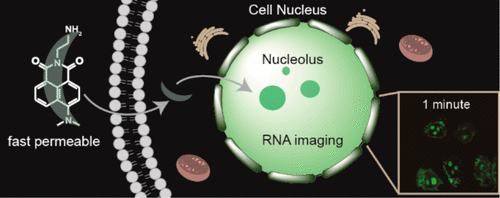Our official English website, www.x-mol.net, welcomes your
feedback! (Note: you will need to create a separate account there.)
Ribosomal RNA-Selective Light-Up Fluorescent Probe for Rapidly Imaging the Nucleolus in Live Cells
ACS Sensors ( IF 8.2 ) Pub Date : 2019-04-24 00:00:00 , DOI: 10.1021/acssensors.9b00464
Chunyan Cao 1 , Peng Wei 1 , Ruohan Li 1 , Yaping Zhong 1 , Xiang Li 2 , Fengfeng Xue 1 , Yibing Shi 1 , Tao Yi 1
ACS Sensors ( IF 8.2 ) Pub Date : 2019-04-24 00:00:00 , DOI: 10.1021/acssensors.9b00464
Chunyan Cao 1 , Peng Wei 1 , Ruohan Li 1 , Yaping Zhong 1 , Xiang Li 2 , Fengfeng Xue 1 , Yibing Shi 1 , Tao Yi 1
Affiliation

|
RNA-based fluorescent probes are currently limited by their low selectivity toward RNA versus DNA, and low specificity to different RNA structures. Poor membrane permeability is another defect of existing fluorogenic RNA probes for intracellular imaging. In this work, a naphthalimide derivative, probe 1, was developed for the rapid and selective detection of intracellular rRNA (rRNA). Probe 1 exhibited a 32-fold fluorescent enhancement in response to rRNA binding and showed desirable selectivity for rRNA versus DNA and other nucleic acids in phosphate buffer at pH 7.2. Importantly, probe 1 displayed excellent permeability of the nucleolus, could be taken up in 1 min by four different cell lines, and may be the fastest nucleolus dye. The excellent selectivity of probe 1 toward rRNA is attributed to the specific interaction between the complicated 3D structures of rRNA, which was confirmed by quantum calculations using molecular docking simulations. An appropriate lipophilic balance in 1 with the hydrophilic amine group and hydrophobic naphthalimide, as well as its high water solubility, guarantees the high permeability of 1 in cell membranes and nucleolus pores, compared to other analogues (e.g., probes 2–8 in this work). Furthermore, enlarged confocal laser micro images of nucleoli and RNase digestion tests revealed that 1 remained highly selective toward rRNA, even for intracellular imaging. As a live cell probe, 1 also exhibited better photostability than the commercial RNA dye, SYTO RNA select.
中文翻译:

核糖体RNA选择性点亮荧光探针,用于快速成像活细胞中的核
目前,基于RNA的荧光探针因其对RNA的相对于DNA的低选择性以及对不同RNA结构的低特异性而受到限制。膜通透性差是现有的用于细胞内成像的荧光RNA探针的另一个缺陷。在这项工作中,开发了萘二甲酰亚胺衍生物探针1,用于快速选择性地检测细胞内rRNA(rRNA)。探针1响应rRNA结合表现出32倍的荧光增强,并且在pH 7.2的磷酸盐缓冲液中,相对于DNA和其他核酸,rRNA表现出理想的选择性。重要的是,探针1核仁具有极好的渗透性,可以在1分钟内被四种不同的细胞系吸收,并且可能是最快的核仁染料。探针1对rRNA的优异选择性归因于rRNA复杂3D结构之间的特异性相互作用,这已通过使用分子对接模拟的量子计算得到了证实。在适当的亲脂平衡1与亲水性胺基团和疏水萘二甲酰亚胺,以及其高水溶性,保证了高磁导率1在细胞膜和细胞核的孔,相对于其他的类似物(例如,探针2 - 8在这项工作中)。此外,核仁和RNase消化测试的放大共聚焦激光显微图像显示,即使对于细胞内成像,1仍对rRNA具有高度选择性。作为一种活细胞探针,1还显示出比市售RNA染料SYTO RNA select更好的光稳定性。
更新日期:2019-04-24
中文翻译:

核糖体RNA选择性点亮荧光探针,用于快速成像活细胞中的核
目前,基于RNA的荧光探针因其对RNA的相对于DNA的低选择性以及对不同RNA结构的低特异性而受到限制。膜通透性差是现有的用于细胞内成像的荧光RNA探针的另一个缺陷。在这项工作中,开发了萘二甲酰亚胺衍生物探针1,用于快速选择性地检测细胞内rRNA(rRNA)。探针1响应rRNA结合表现出32倍的荧光增强,并且在pH 7.2的磷酸盐缓冲液中,相对于DNA和其他核酸,rRNA表现出理想的选择性。重要的是,探针1核仁具有极好的渗透性,可以在1分钟内被四种不同的细胞系吸收,并且可能是最快的核仁染料。探针1对rRNA的优异选择性归因于rRNA复杂3D结构之间的特异性相互作用,这已通过使用分子对接模拟的量子计算得到了证实。在适当的亲脂平衡1与亲水性胺基团和疏水萘二甲酰亚胺,以及其高水溶性,保证了高磁导率1在细胞膜和细胞核的孔,相对于其他的类似物(例如,探针2 - 8在这项工作中)。此外,核仁和RNase消化测试的放大共聚焦激光显微图像显示,即使对于细胞内成像,1仍对rRNA具有高度选择性。作为一种活细胞探针,1还显示出比市售RNA染料SYTO RNA select更好的光稳定性。

































 京公网安备 11010802027423号
京公网安备 11010802027423号